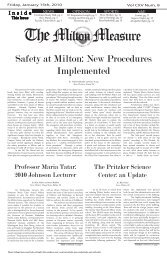Spring 2007 - Milton Academy
Spring 2007 - Milton Academy
Spring 2007 - Milton Academy
- No tags were found...
You also want an ePaper? Increase the reach of your titles
YUMPU automatically turns print PDFs into web optimized ePapers that Google loves.
Kate Grossman Sutliff ’91Director of Housing, LISC New YorkJennie Bartlett ’00Assistant Program Officer, Office of the ChiefOperating Officer, LISC Washington, D.C.Local Initiatives Support Corporation (LISC)has generated $7.1 billion in communitybuilding investments, which in turn leveraged$16.7 billion in total development. Thesefunds have helped build or rehabilitate196,000 affordable homes and nearly 27 millionsquare feet of retail, community andeducation space across the country.In New York, Kate works with LISCwhere the concept was bornAfter the nation viewed the 1977 devastationand arson in the South Bronx, theneed to regenerate the country’s pooresturban neighborhoods was brought intourgent focus. To support the resident-ledcommunity groups on the frontlines combatingthe increasing blight, the FordFoundation helped found a new type oforganization in 1979: the Local InitiativesSupport Corporation, more commonlyknown as LISC.While LISC began as a very targeted effortto help combat the major abandonment,arson, crime and disinvestment that wasplaguing the South Bronx in the 1960sand ’70s, it has since grown into a nationalleader in community development, workingin both urban and rural locationsaround the country. Today, LISC brings aholistic view to community development,helping transform distressed neighborhoodsinto healthy communities wherepeople have access to affordable homes,jobs, reliable places to shop, and highqualityschools.Kate Grossman Sutliff ’91 is the director ofhousing at LISC’s New York City office,which works with community developmentcorporations (CDCs) in low-incomeneighborhoods primarily in Brooklyn,Harlem and the South Bronx. “CDCs typicallybegin as local, grass-roots, nonprofitorganizations,” says Kate, “that were willingto step up and take responsibility foradvocating for local residents and rebuildingtheir neighborhoods.”New York City CDCs have faced a remarkableshift in the development landscapeover the years, according to Kate. In the1980s, the city had a huge inventory of taxforeclosedproperties, which they decidedto sell to community developers for onedollar, and in exchange, the developer builtaffordable homes and apartments. Due tothe huge success of the program, this lowcostinventory is now nearly depleted, andnew challenges abound. “It’s hard enoughto develop affordable housing with today’srising construction costs; imagine addingNew York City’s high acquisition prices tothe cost of development,” Kate says.“In today’s environment, CDCs have to beextremely entrepreneurial,” explains Kate.“The Fifth Avenue Committee, a BrooklynCDC we work with, recently launched aninitiative to build affordable housing in theunderutilized space on top of publiclibraries. This innovative approach solvestwo problems at once. Outdated and deterioratinglibraries are modernized andrejuvenated, and much-needed affordablehousing is brought to a neighborhoodwhere space for new housing is at a premium.Putting a project like this togetherrequires a whole new approach to doingbusiness; CDCs are redefining as theyadapt to this changing environment.”Kate started at LISC as a community developmentofficer (CDO), responsible for abroad portfolio of CDCs, working on whateverdeals her CDCs were developing.“You build a broader array of skills workingwith multiple partners on a wide varietyof projects—an approach that alsohelps keep you interested and challengedday-to-day. This structure also benefits theCDCs; with a single point person, a groupgets a true advocate for its organization.”Currently, as director of housing, Kateoversees the CDOs and her primary focushas shifted to management: training, troubleshooting,supervising, as well as spendingtime outside the office making surethe work CDCs are doing is visible.Kate’s path to LISC led her through severaldifferent states and disciplines. After shegraduated from Amherst College, shemoved to San Francisco and began work atthe Federal Reserve Bank. She then earnedher MBA at Wharton, which was “a greatcomplement to my liberal arts education,”Kate says. “I’ve always been committed topublic interest work, but believe that nonprofitsshould function just as entrepreneurially,creatively, and efficiently asfor-profit companies, with the same levelof accountability to their stakeholders.”After graduating, Kate moved to New Yorkto continue work she had started withEdison Schools during the previous summer—helpingopen a charter school onthe South Side of Chicago, and leadingEdison’s national principal-recruitmentefforts. From Edison, Kate joined LISC,where she has been for the past five and ahalf years. She continues her commitmentto bringing quality education to lowincomecommunities by serving on theboard of trustees of the Harlem LinkCharter School.“I am wired to seek out challenges in mywork, and this work is certainly challenging,”Kate notes. “A job like this feeds allparts of me. I love numbers, and I get tospend a lot of time on financial modelingand underwriting. Relationship buildingis another critical facet of each day, andI enjoy the strong team environment hereat LISC. Finally, I’m constantly energizedby being part of the citywide effort tostrengthen New York City’s most vulnerablefamilies and communities.”CDEKate Grossman Sutliff ’9119 <strong>Milton</strong> Magazine
















